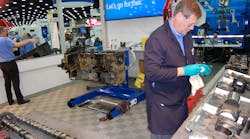As more engine makers aim to push the use of low viscosity oils for their products, mainly in a bid to comply with ever-tighter heavy truck fuel economy mandates, fleets are voicing concerns about the long-term protective capability of such “thinner” oil – a concern lubricant makers are trying to dispel via a variety of outreach efforts.
Chevron Products Co. served up the most recent iteration of such “outreach” during a series of engine teardowns conducted at the Mid America Trucking Show last month.
“The big concern for a lot of fleets is protection,” Jim Gambill, Chevron’s North America Commercial and Industrial brands manager, told Fleet Owner. “Even though about a third of the trucking market has converted to low viscosity oils, most fleets don’t have the luxury to try something out to see if it works. They want more concrete proof that it works, which is why we’ve been conducting such ‘live’ engine teardowns in the market.”
Gambill explained that, from the fleet perspective, any fuel economy savings generated from using low viscosity oils won’t be worth it if the protective capability of the oil is compromised. “Simply put, the dollars gained just aren’t worth it if the [low viscosity] oil can’t protect the engine like today’s thicker oils can,” he stressed.
That’s the reason why Chevron took its engine teardown on the road, he noted – to show that a lighter 10W-30 oil blend offered protection comparable to a thicker 15W-40 blend in a DD15 engine with over 400,000 mi. of service on it.
“We made sure via the teardown exercise that fleets and truck operators could see all the vital parts vulnerable to excessive wear – particularly the cam, cam shaft, and piston linings – were in the same if not better condition when using 10W-30,” Gambill said. “Having that protection is critical to obtaining the full fuel economy savings of the low viscosity oil.”
He added that the price differential between 10W-30 and thicker 15W-40 blends is not large, with the 10W-30 blends typically costing 10% more and sometimes only 5% more based on volume discounts, with the lower viscosity formula able to deliver about a 1% to 2% fuel economy savings based on Chevron customer fleet tests.
“When we isolate the engine oil performance in the lab, we see savings of about up to 1% – but even a half percent gain in fuel economy can save significant money over time when diesel is costing near the $4 per gallon mark,” Gambill explained. “Not only that, we’re seeing reduced use of diesel exhaust fluid (DEF) and longer oil filter life as well so there are ‘ripple effect’ savings to be gained as well by switching to lower viscosity engine oils.”
He added, too, that the trend towards smaller displacement engines – downsizing from 15 liter to 13 liter models to help save on weight – adds another dimension of savings potential for lower viscosity oil blends.
“You tend to generate more fuel savings from low viscosity oils when engine RPMs increase, simply because the engine isn’t working as hard with the thinner oil at that those higher RPMs,” Gambill said. “Thus is the engine works less at higher RPMs, the bigger the fuel savings. That’s the key trend here.”



